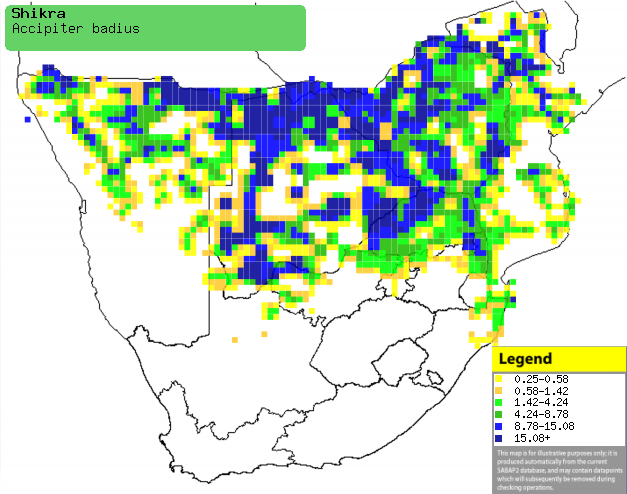|
Accipiter badius (Shikra,
Little banded goshawk)
Gebande sperwer [Afrikaans]; Fiolo-'malisakhana [South
Sotho]; Rukodzi (generic name for a small raptor such as falcon or
sparrowhawk) [Shona]; Shikra [Dutch]; Épervier shikra [French]; Schikra
[German]; Gavião-chicra [Portuguese]
Life
> Eukaryotes >
Opisthokonta
> Metazoa (animals) >
Bilateria >
Deuterostomia > Chordata >
Craniata > Vertebrata (vertebrates) > Gnathostomata (jawed
vertebrates) > Teleostomi (teleost fish) > Osteichthyes (bony fish) > Class:
Sarcopterygii (lobe-finned
fish) > Stegocephalia (terrestrial
vertebrates) > Tetrapoda
(four-legged vertebrates) > Reptiliomorpha > Amniota >
Reptilia (reptiles) >
Romeriida > Diapsida > Archosauromorpha > Archosauria >
Dinosauria
(dinosaurs) > Saurischia > Theropoda (bipedal predatory dinosaurs) >
Coelurosauria > Maniraptora > Aves
(birds) > Order: Falconiformes
> Family: Accipitridae
> Genus: Accipiter
Distributed through southern Asia, the Arabian Peninsula and
sub-Saharan Africa. Found in open and closed woodlands, including in open
semi-arid savanna. Lizards are the main item in its diet but it also eats
insects, small birds, and more occasionally bats, rodents and frogs.
Distribution and habitat
Occurs from southern Asia and the Arabian Peninsula to
sub-Saharan Africa, excluding the lowland forest of the DRC and West Africa. In
southern Africa, it is scarce to common
in the northern half of the region, including northern Namibia, Botswana and
Zimbabwe, Mozambique and north-eastern South Africa. It can occur in a variety of
woodland types, ranging from the open Kalahari to moist, closed-canopy broad-leaved
woodland; it may also occupy gardens, parks and plantations.
|
 |
|
Distribution of Shikra in southern Africa,
based on statistical smoothing of the records from first SA Bird Atlas
Project (©
Animal Demography unit, University of
Cape Town; smoothing by Birgit Erni and Francesca Little). Colours range
from dark blue (most common) through to yellow (least common).
See here for the latest distribution
from the SABAP2. |
Predators and parasites
Movements and migrations
Its movements are not well understood, but it is thought to be
largely resident. However, it tends to aggregate in western
Zimbabwe and north-eastern South Africa in winter, which suggests
that it might be a partial migrant.
Food
It mainly eats lizards, hunting by flying from tree to
tree, pausing on each perch to scan the surrounding area for prey. Once it spots something, it
swoops down to the ground to pounce on its prey. The following food items have been recorded
in its diet:
- Vertebrates
- lizards
- birds
- mammals
- frogs
- Invertebrates
Breeding
- Monogamous, territorial solitary nester, performing a courtship display in
which the breeding pair chase each other through the trees.
- The nest is built by both sexes, consisting of a saucer-shaped platform
of twigs, with an interior cup lined with bark chips. It is typically placed in the fork of a
large branch, especially of the following trees:
- Eucalyptus
- Jacaranda acutifolia (Jacaranda)
- Burkea africana (Burkea)
- Acacia nigrescens (Knob-thorn)
- Acacia erioloba (Camel thorn)
- Brachystegia glaucescens (Mountain-acacia)
- Kirkia acuminata (White kirkia)
- Colosphermum mopane (Mopane)
- Terminalia sericea (Silver cluster-leaf)
- Egg-laying season is from August-February, peaking from
September-November.
- It lays 1-4 eggs, which are mainly incubated by the female for about
28-29 days, while the male feeds her at the nest. He may occasionally take
over the incubating role so that the female can go and forage.
- For the first two weeks or so of the chicks' lives they are cared for by
the female, who feeds herself and her young with food provided by the
male; after this period the female joins the male hunting. The chicks
start exploring the nest tree at about 22 days old, fledging after another
10 days or so and becoming independent 30-40 days later. They tend to remain
in their parent's territory for up to a year after fledging.
Threats
Not threatened.
References
-
Hockey PAR, Dean WRJ and Ryan PG 2005. Roberts
- Birds of southern Africa, VIIth ed. The Trustees of the John Voelcker
Bird Book Fund, Cape Town.
|
